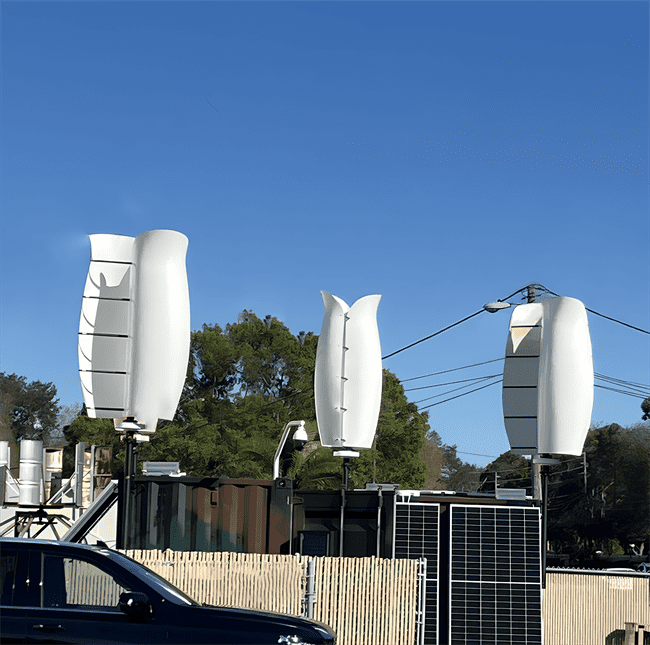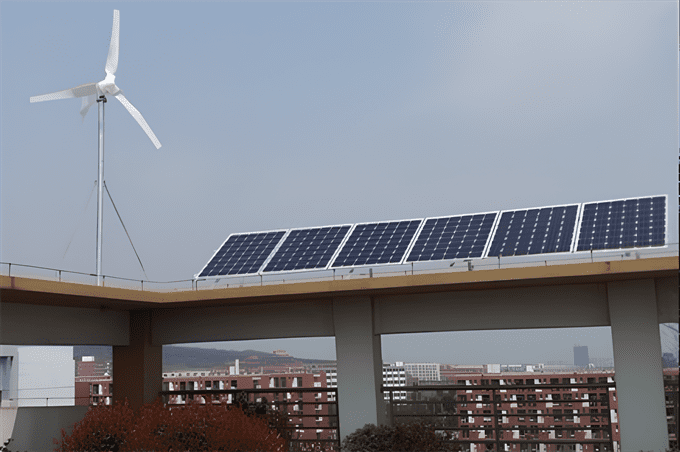Wind power has rapidly developed worldwide as a clean and renewable energy source. Besides traditional wind turbines, innovative applications are expanding to maximize benefits. This article explores the field application innovation of wind turbines, including extension, cross-border utilization, and integrated development. It highlights the endless possibilities of wind energy through relevant cases and data.
1. Extension of traditional wind power generation: improving efficiency and reducing costs
Traditional wind power faces efficiency and cost challenges. Innovations in wind turbines aim to improve efficiency, cut operating costs, and broaden wind energy utilization across various fields.
1.1 Wind turbine blade innovation:
Blade material innovation: New composite materials like carbon fiber and glass fiber reduce weight, enhance strength, and boost power generation efficiency.
Blade shape optimization: Airfoil design and other optimizations minimize wind resistance and improve efficiency.
Blade control technology: Intelligent control adjusts blade angle based on wind speed, enhancing efficiency and reducing noise pollution.
1.2 Innovation of wind turbine control system:
Intelligent control system: It automatically adjusts wind turbine operations based on factors like wind speed and direction, enhancing efficiency and reducing costs.
Predictive maintenance: Sensors and data analysis enable proactive equipment failure predictions, timely repairs, cost reduction, and improved reliability.
1.3 Miniaturization of wind turbines:
Micro wind turbines: Micro wind turbines can be installed on building roofs, street lamp poles and other places to provide clean energy for homes and businesses and reduce energy costs.
Portable wind turbines: Portable wind turbines can provide power supply for outdoor activities, emergency rescue, etc., bringing convenience to people’s lives.

2. Cross-border application: Integrating wind energy into multiple scenarios
The innovation of wind power generation technology is not limited to traditional power production, but continuously expands the application field, integrates wind energy into multiple scenarios, and brings more benefits to human society.
2.1 Combining wind power generation with energy storage technology:
Wind-solar complementarity: Integrating wind and solar power generation effectively addresses the intermittent nature of these energy sources, enhancing energy supply stability.
Energy storage system: Combining wind power generation with energy storage stores surplus electricity for later use, improving energy utilization efficiency and reducing costs.
2.2 Combining wind power generation with transportation:
Wind electric vehicles: These vehicles use electricity generated by wind power, reducing carbon emissions and promoting green transportation development.
Wind ships: These ships are powered by electricity from wind turbines, reducing fuel consumption and enhancing navigation efficiency.
2.3 Combining wind power generation with agricultural production:
Wind irrigation system: Using wind power-generated electricity to drive irrigation systems conserves water resources and enhances agricultural production efficiency.
Wind breeding system: Utilizing wind power-generated electricity for lighting, ventilation, heating, and other services in breeding farms improves breeding efficiency and reduces costs.
3. Integrated development: Wind power generation integrates with other technologies
Innovation in wind power relies on the integrated development of technologies like artificial intelligence, big data, and the Internet of Things. These advancements enhance the efficiency and benefits of wind power generation.
3.1 Artificial intelligence and wind power generation:
Intelligent control system: AI optimizes wind turbine operation, boosting power generation efficiency and reducing costs. Machine learning adjusts parameters like blade angle and generator speed based on factors like wind speed, direction, and temperature for maximum efficiency.
Fault prediction: AI analyzes turbine data to predict equipment failures, enabling timely repairs and enhancing reliability. Deep learning identifies abnormal operation modes and provides advance warnings of potential failures, preventing downtime losses.
3.2 Big data and wind power generation:
Wind energy resource assessment: Big data analysis identifies optimal wind energy resource areas, aiding wind farm site selection. Historical wind speed, topographic, and meteorological data can be analyzed to create wind energy resource distribution maps.
Operation optimization: Big data analysis of wind farm operation data optimizes power generation efficiency and reduces costs. By analyzing power generation data at various wind speeds, parameters like blade angle and generator speed can be optimized for improved efficiency.
3.3 Internet of Things and Wind Power Generation:
Remote monitoring: IoT enables real-time monitoring of wind farms, detecting equipment status and promptly identifying faults for remote diagnosis and maintenance. Sensors monitor parameters like blade speed, generator temperature, and wind speed, transmitting data to the monitoring center for efficient remote management.
Intelligent operation and maintenance: IoT facilitates intelligent operation and maintenance of wind farms, enhancing equipment reliability and reducing costs. Sensors and data analysis enable predictive maintenance, timely repairs, and prevention of equipment downtime losses.
4. Case analysis of application innovation in wind power generation
4.1 Offshore wind power generation:
Offshore wind power generation is an important development direction in the field of wind power generation, and has made significant progress in recent years.
The construction and operation of offshore wind farms face many challenges, such as harsh offshore environment and high construction costs.
In order to meet these challenges, many innovative technologies have emerged, such as:
Floating wind turbines
Large offshore wind turbines
Intelligent management system
4.2 Combination of wind power generation and energy storage technology:
The combination of wind power generation and energy storage technology can effectively solve the intermittent problem of wind energy and improve the stability of energy supply.
At present, there are mainly the following ways to combine wind power generation and energy storage technology:
Battery energy storage:
Wind power generation energy storage technology includes battery energy storage and pumped storage. Battery energy storage uses lithium-ion batteries, sodium-ion batteries, etc. to store wind power generation electricity and release it on demand to improve energy utilization efficiency. Pumped storage uses wind power generation electricity for pumped storage, and generates electricity through water flow when released. These technologies promote the development of wind power generation and energy storage and improve energy utilization efficiency.
Compressed air energy storage:
Wind power-generated electricity is used to compress air, which is then released to generate electricity when needed, enabling energy storage. Compressed air energy storage technology is a promising energy storage solution with significant advantages such as large capacity, high safety, and low cost, holding great potential for future development.
4.3 Combination of wind power generation and smart city construction:
The combination of wind power generation and smart city construction can provide clean energy for smart cities and promote the sustainable development of cities.
At present, the application of wind power generation in smart city construction mainly includes the following ways:
Distributed wind power generation:
Install wind turbines on building roofs, street lamp poles and other places to provide clean energy for urban residents. For example, small wind turbines are installed on the roofs of urban buildings to provide residents with clean energy, reduce energy consumption, and reduce carbon emissions.
Wind electric vehicle charging pile:
Use the electricity generated by wind power generation to charge electric vehicles and promote the electrification of urban transportation. Wind power charging stations are established in public areas of cities, utilizing wind-generated electricity to charge electric vehicles. This initiative promotes the adoption of electric vehicles and helps reduce urban traffic pollution.
Smart energy management system:
Leveraging technologies like the Internet of Things, big data, and artificial intelligence enables intelligent urban energy management, enhancing energy utilization efficiency and reducing consumption. A smart energy management system monitors real-time energy consumption, optimizes energy distribution, improves efficiency, and lowers energy costs.
5. Future prospects of wind power generation: intelligent, diversified, and sustainable
The future of wind power generation will show the following trends:
Intelligence: Artificial intelligence, big data, and the Internet of Things will deeply integrate into wind power generation, optimizing operation control, predicting faults, and enabling remote monitoring. This integration will enhance efficiency and reduce costs.
Diversification: Wind power generation will expand beyond traditional power production, integrating with energy storage, transportation, agriculture, and other fields. This diversification will broaden application scenarios and provide clean energy for various sectors.
Sustainability: Wind power generation will prioritize environmental protection, minimizing impacts on ecosystems and residents, and striving for sustainable development.
In summary, continuous innovations in wind power generation will bring numerous benefits to society, promoting the advancement of clean energy and fostering sustainable development.

